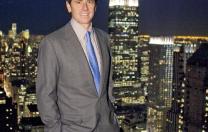“Feel that?” asks engineer Paul Rode, straining to open a steel door to a stairwell on the sixtieth floor of the Empire State Building. “That’s a seven-and-a-half-mile-an-hour wind.” The steady blow is caused by the stack effect, the natural tendency of a building to act like a giant chimney, creating a draft that draws air upward. “We installed automatic dampers to control the airflow, so that the building is ventilated” naturally, explains Rode, of Johnson Controls, which oversaw engineering for the recent retrofit of the iconic skyscraper.
Opened and closed mechanically, dampers modulate the airflow of the entire building depending on outdoor temperatures. That enabled removal of electric-powered fans that did the same thing. But the key to making a building energy efficient, he emphasizes, is not the specific retrofits chosen, but rather taking the right steps in the right order. Rode calls it “design priority,” and says it is true for every building.
The first step is load reduction: reducing a building’s energy consumption. “You [do it] the same way you would at home,” he explains: “insulation, better windows, caulking in the joints.” Turning lights off when you have plenty of sunlight is another method. At the Empire State Building, dropped ceilings were removed so more sunlight could reach the core office spaces, reducing the need for artificial lighting. Every desk now has a window in view. Straightening pipes is another load-reducing strategy, as is installing radiative barriers behind steam heaters so that heat is reflected into the building rather than out through the exterior wall. Such measures, Rode explains, mean “your power plant doesn’t have to supply as much energy that gets dissipated along the way.”
Next comes a focus on energy efficiency—the “classic area everyone gets stuck on and likes to talk about,” he says: “more efficient heaters and pumps and lights and air conditioning and LCD monitors, and offices with sensors that dim the lights when natural light is sufficient.” All these measures were incorporated into the retrofit, along with tenant guidelines that result in energy-efficient outfitting of newly leased office space.
Awareness is the third, and continuing, contributor to increasing efficiency. Everyone in the Empire State Building, from occupants to operators, now knows how much energy they are using per square foot, how that compares to the energy used by other people doing similar work in similar circumstances, and what steps they could take for optimal efficiency. Information is based on software calculations; the building’s operations staff gets daily reports on energy use so they can make any adjustments needed to have an immediate effect. “Over time,” Rode says, “these signals can get people to change their habits.”
For the Empire State retrofit, Johnson Controls considered not only all these logical steps, but every other upgrade the combined project team could think of, many of which never saw the light of day. An egg-beater-like wind turbine on the building’s spire that might have generated power was rejected, for example, because of the impact on the skyline relative to the small amount of electricity (25 kilowatt hours—enough to power a typical home) it would have produced. Solar panels on the building’s setback roofs were deemed too costly, and capturing rainwater for use in toilets proved uneconomical because water is relatively cheap in Manhattan.
The idea was to create “a list of projects that would result in the theoretical minimum energy use of the building,” Rode explains. “That concept is important, because until this job, people have approached energy projects in buildings from the perspective of how much they can drive energy use down: 5 percent savings, 10 percent savings.” By starting instead with the minimum energy use and then letting “economic constraints and business constraints push that bar up, I have a much more rational design process. I know how much money I have to invest. I know what the endpoint is. And I very quickly understand when I reach that point.”








